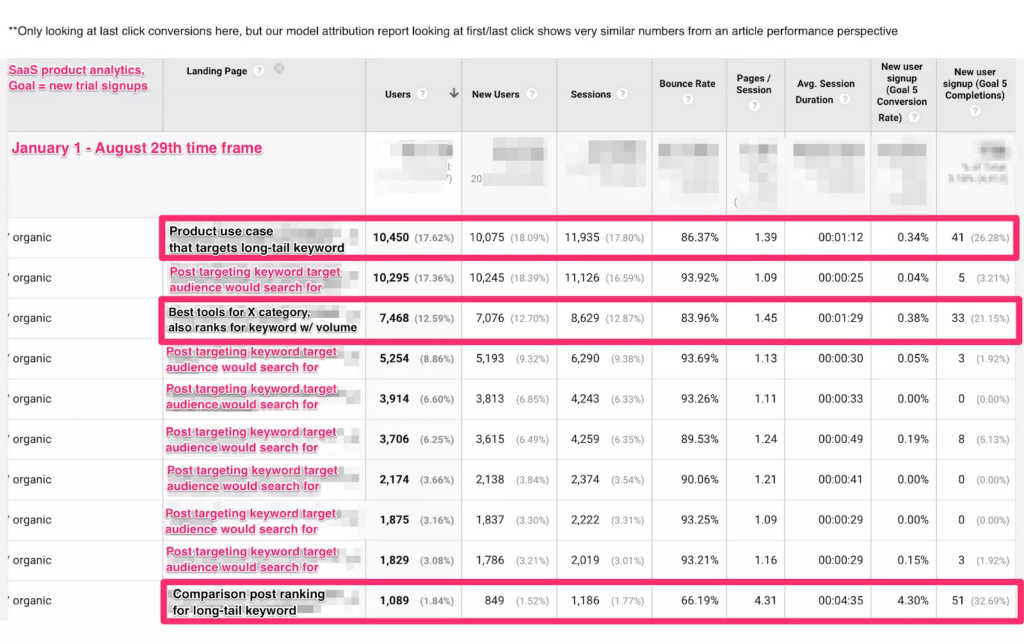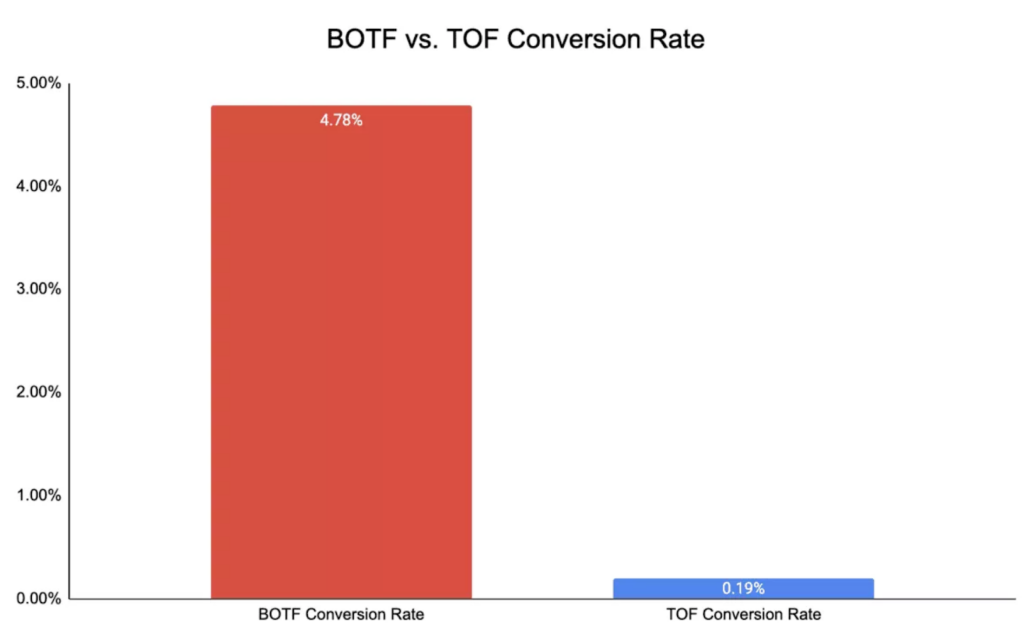Conversion rate optimization (CRO) for content is a unique process that is markedly different from general purpose CRO of homepages, landing pages, and eCommerce sites. It involves creating blog posts that (a) rank for valuable SEO keywords and (b) sell a product or service through compelling long form content.
In contrast to general purpose CRO, which often centers around doing A/B testing to improve a website’s conversion rate, content CRO has some key factors that precede (and are of greater importance than) running AB tests:
- Targeting keywords that have buying intent. In our experience, as we’ll demonstrate below, this is by far the #1 driving factor that determines whether or not content converts.
- Ranking highly for those keywords. To get sustainable traffic and conversions from content, you need to at least rank on page one of search results, ideally in the top three positions.
- Writing compelling content that sells your product or service. Converting readers into customers requires intelligent, thoughtful writing that demonstrates how your product or service solves the customer’s problem. Doing this well (while difficult) can significantly influence conversion rates.
With that said, there are aspects of general practice CRO that still apply to content. So, in this post we’re going to share 9 practices that — based on our experience measuring conversions of hundreds of blog posts for dozens of clients — every company should follow to optimize their content for conversion.
We’ve grouped these steps into three categories:
1. Focus on targeting high buying intent SEO keywords
2. Optimize content to rank for those keywords
3. Write non-generic blog introductions
4. Highlight customer pain points
5. Describe how your product or service solves those pain points
6. Emphasize your unique differentiators
7. Have a clear call-to-action in your navigation bar
8. Optimize your blog design for readability
9. Use in-line contextualized CTAs throughout your blog copy
Note: If you’d like help improving your blog conversion rate, you can learn more about our agency here and reach out about working with us here.
SEO
Search engine optimization (SEO) — the process of choosing keywords and optimizing content to rank for those keywords in organic search — plays a critical role in optimizing content for conversion because:
- Without sustainable traffic to your content, making CRO tweaks to your site won’t matter. (i.e. You can’t analyze and influence user behavior if there aren’t enough users on your site to begin with.)
- By intentionally targeting keywords that indicate searchers have buying intent, SEO offers a unique opportunity to bring in highly targeted website traffic which can drastically increase conversion rates.
For these reasons, the following two aspects of SEO are where we focus first when optimizing content for conversion.
1. Focus On Targeting High Buying Intent SEO Keywords
The logic behind this point is simple:
If a piece of content ranks for keywords in which people searching have intent to buy what you sell, it will convert at a higher rate than if it ranks for keywords in which people do not have intent to buy what you sell.
This point is neatly summarized in this Google analytics screenshot from our article on Pain Point SEO (our agency’s foundational SEO content strategy):

The right-most column shows new user signups for each of the URLs listed. The three boxed posts follow the Pain Point SEO approach and rank for keywords with high buying intent. The rest rank for something the target audience could search for, but not a high buying intent keyword.
The number of conversions from the three Pain Point SEO posts are hundreds of percent higher.
We also showed this at a larger scale in a case study that analyzed 60+ posts for our client Geekbot:

The posts targeting high buying intent keywords (which we’ve traditionally referred to as “bottom of funnel”) didn’t just convert at 10%, 20% or even 50% better than the “top of funnel,” lower-intent posts, they converted 2400% better. And furthermore, the higher conversion rates more than made up for any differences in search volume or traffic between the two buckets.
No AB or split testing is going to get you a 2400% lift in average conversion rate. That’s why we say this is the #1 factor, by far, in content conversion optimization.
If you do nothing else, simply ranking for keywords where people are actively looking to buy what you sell will inevitably increase conversions from your content.
2. Optimize Content to Rank for Those Keywords
In addition to focusing on the right keywords (i.e. ones that can drive actual paying customers), you need to write content that’s optimized to rank highly for those keywords. Ideally, in the top half of page one of search results where the majority of traffic comes from.
This is nontrivial. You can’t just “sprinkle” keywords into an article and expect your post to rank for a competitive, valuable business keyword. For example, category keywords such as “social media management software” or “executive assistant service.”
The process is much more involved than that.
We’ve written at length about how we approach content optimization here which breaks down our process into the following five steps:
- Topic: Come up with content ideas and identify target keywords that have business value.
- SERP Analysis: Analyze the search engine results page (SERP) for each of those keywords to understand which topics need to be covered in your article for it to rank.
- Structure: Choose the angle and structure of your article based on that SERP analysis.
- Writing: Write the content in a way that fills in that structure with compelling information to sell your product or service.
- On-Page SEO: Polish off your content with on-page SEO.
Read our full post which provides detailed explanations and examples for each step: SEO Content Writing: A 5-Step Process You Can Follow
Content Writing
Content writing itself is a highly underrated aspect of content CRO strategy because people tend to focus on general purpose CRO as we mentioned above. For example, using pop-ups, analyzing heatmaps, decreasing web page load times, or using social proof and customer testimonials.
But converting readers into customers requires selling your product or service inside blog posts, which is a very different style of blog writing than typical top of funnel how-to or intro-guide style posts. The following are the most important aspects of writing content that converts.
3. Write Non-Generic Blog Introductions
The internet is fraught with generic, cliche blog introductions that can turn off potential customers and cause high bounce rates. This is particularly true in the B2B space where website visitors are often advanced in the topic area of the content.
For example, for an article aimed at attracting sales managers and selling them on a CRM tool, if it starts off with descriptions about how CRMs are really important to tracking sales data, it’s an immediate turn offs to actual, experienced sales managers. These articles are written below the knowledge level of the target audience and the introduction is what gives that away.
If you write generic introductions, you show the reader that you aren’t on their level, you fail to entice readers to keep reading, and you’ll lose a chunk of them, thereby reducing your conversion rate right out of the gate. So, getting your introductions right is essential.
This is a topic that one of our founders, Devesh, has written about at length in a previous piece: How to Write Great Blog Introductions (And Why Most Are Bad)
He compares and contrasts good introductions with bad ones, so you can learn how to write better introductions that hook readers and cause them to keep reading.
4. Highlight Customer Pain Points
In the same fashion that you would discuss customer pain points on a product page or sales landing page, highlighting pain points in your blog content is another key aspect of optimizing content for conversion.
If you can hit on pain points that resonate with readers, particularly early on in a post (and in language that they use themselves to describe their problems), you can:
- Earn their trust and attention.
- Entice them to continue reading.
- Naturally transition into discussing how your product or service can solve those problems, and thus generate conversions.
Check out this post to learn how to identify customer pain points that you can highlight in your content: Content Ideation: How to Identify Content Ideas That Convert
5. Describe How Your Product or Service Solves Those Pain Points
Most blog content only glancingly mentions the company’s product or service, if it does so at all. This is in part due to the top of funnel, non product-centric topics that blogs often focus on. And in part due to a culture of content marketing that says you shouldn’t be too “salesy” in your content. This is a massive conversion mistake that many brands make.
If you don’t discuss your product or service in your content, you’re guaranteeing it won’t convert well. Plus, if you’re not discussing your product, someone else will.
Particularly if you focus on buying intent topics as we discussed above, discussing your product or service is actually necessary to satisfy search intent. Searchers are looking to understand how your product works, whether it can solve their problems, and how it’s different from other solutions. So, this is exactly what you need to discuss in order to rank for buying intent keywords and convert readers into leads and customers.
When writing content for our clients, significant portions of our copy (50%+) are dedicated to describing the features and benefits of the product or service, highlighting the key value propositions, and demonstrating the ways in which our client can solve the customer’s pain points.
For an in-depth tutorial on the pitfalls of writing product-focused content, and how to execute it well, check out: Pain Point Copywriting: How to Write Compelling Sales Copy Inside Blog Posts
6. Emphasize Your Unique Differentiators
Finally, as you discuss how your product or service solves customer pain points, it’s important to emphasize your unique differentiators. This is a key aspect of helping readers understand how your product or service is different and why they should choose you over your competitors.
In our experience evaluating thousands of applicants and reviewing hundreds of test projects, we’ve learned that hiring writers to do this type of Pain Point Copywriting is difficult. Learn more about how to solve that here.
If you want help doing this type of sales-focused content marketing, you can learn more about our service here.
Blog Design and CTAs
Finally, after all of the above steps, we get to what most people think are the important aspects of “conversion optimization” for content: design, UX, call-to-action (CTA) placements and the like. For us, this bucket intentionally comes last. As we’ve argued before, blog design, CTAs, and other visual aspects of CRO are akin to the “window dressing” of conversion optimization, you should only focus on them after you take care of the fundamentals above.
Why? Because the steps above ensure (a) the traffic to your content has a high intent to purchase (b) the content itself is written to compel them to purchase. If you have those two aspects in place, then these high-intent customers will figure out how to buy. It’s not hard to scroll up to your navbar and learn more about your product, sign up for a trial, reach out, or purchase.
However, this isn’t to say that the aesthetic and user experience aspects of CRO aren’t important for conversion.
What follows are the key aspects of blog design and CTAs that we recommend paying attention to and implementing.
7. Have a Clear Call-to-Action in Your Navigation Bar
Many modern website and blog designs offer the option to include CTA buttons in the top right corner of the page in the navigation bar. However, we’ll occasionally have leads with websites that are missing this element, and we’ll recommend that they fix that.
Having a clear CTA button in the navigation bar makes it simple for readers to reach out if they want to learn more about your product or service; there’s only upside to having that option there. You might even experiment with making your navbar “sticky,” so that the CTA button remains visible to website visitors even as they scroll down the page.
8. Optimize Your Blog Design for Readability
We often see companies crowd their blog pages with graphical CTAs in their sidebars and even throughout their content. In our experience, these graphics can be counterproductive in a few ways:
- They hurt readability making it less likely that people continue reading your entire post.
- They distract readers from focusing on and learning about how your product or service can solve their problems.
- They look like ads which readers are often programmed to ignore anyway.
For these reasons, we recommend that you optimize your blog design for readability — particularly if you’re following the strategy we laid out above and writing compelling content that sells your product or service.
This means using less graphical CTAs, email marketing opt-ins, etc., and using a more minimalist design with clear text that focuses the reader on the content itself. Remember, if you’ve followed the advice above, in particular steps 3–6, your content should be selling your product, so you don’t need graphical ad-looking CTAs in the first place.
9. Use In-Line Contextualized CTAs Throughout the Copy of Your Blog Posts
Lastly, as an alternative to using graphical CTAs, we recommend using plain text, contextualized CTAs throughout your content. When doing this, keep in mind the following:
- Don’t just put CTAs at the end of the article. Many readers won’t make it to the end of your posts, so it’s useful to include CTAs in the introduction and body of the post.
- Don’t use the same exact CTA for every article. Write CTAs that make sense contextually within your post. For example, if the topic of your post is on invoicing, and invoicing is one of a number of features offered by your software platform, make the CTA pertain specifically to your invoicing feature as opposed to your broader platform.
Keep in mind that the advice we’ve provided here on CTAs and design “best practices” are trivial in comparison to the sections on keyword selection and content writing above.
For example, if someone is Googling a super high buying intent term, like “plumbing management app” and they go to a page that explains in detail the ways in which your plumbing management app works, and how it’s better (or different) than competitors, most modern blog layouts have plenty of call-to-action buttons for them to take your desired action (click to learn more, sign up for a demo or trial, etc.).
Get Help Driving Leads & Sales from Your Content Marketing Efforts
- Our Agency: If you want to hire us to execute a content-focused SEO strategy built around driving lead generation and sales, not just traffic, you can view our pricing and learn more about working with us here.
- Join Our Content Marketing Team: If you’re a content marketer or writer and would love to do content marketing in this way, we’d love to have you apply to join our team.
- Our Content Marketing Course: Individuals looking to learn our agency’s content marketing strategy and become better marketers, consultants, or business owners can join our private course and community, taught via case studies, and presented in both written and video content formats. We include several details and examples not found on this blog. Our course is also built into a community, so people ask questions, start discussions, and share their work in the lesson pages themselves, and we, along with other members, give feedback. Learn more here.








